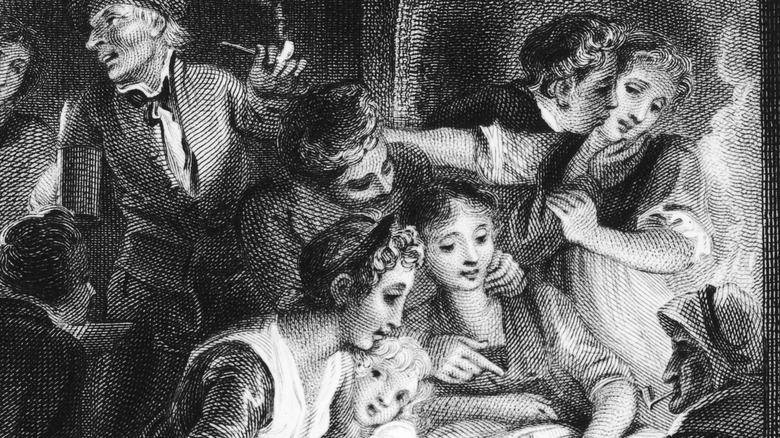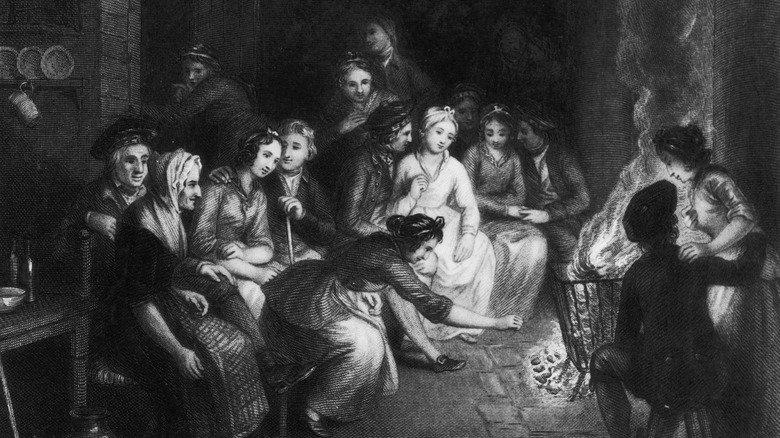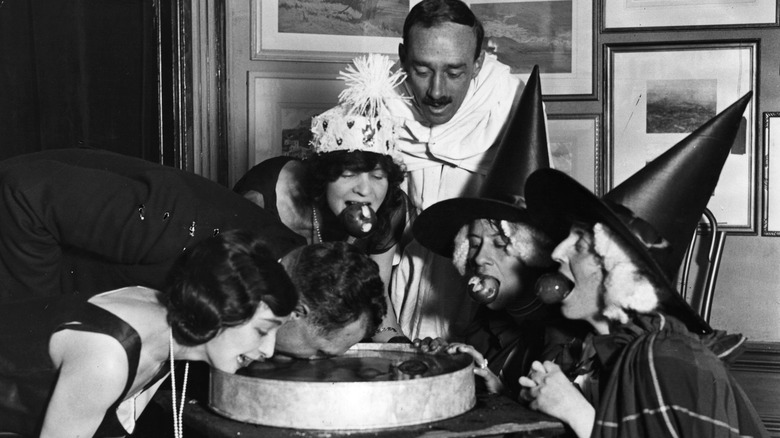Finding A Husband On Halloween Used To Be The Goal In The 1700s
Halloween is a holiday at once ancient and contemporary. Its roots go back to the Celtic festival of Samhain, celebrated since before the Roman invasion and believed to be the time of year when the veil between this world and the "otherworld" was at its weakest. According to Britannica, the bonfires, disguises, and spirits of modern Halloween figured into Samhain rituals. But the ghoulish, horrific aspect of such supernatural activity wasn't always front-and-center, the way it is in our celebration of the holiday. It was more important to take advantage of an opportunity; a weakened division between material and spirit was believed to make for ripe conditions to divine the future.
Divination was part of the Samhain celebrations, per History; as fires roared and participants donned animal skins, they tried to see into the future. Death, naturally, was a subject of interest, but so were affairs of life. Many sought answers in love and marriage through divination, and as Halloween evolved through the Roman and medieval periods into the early modern era, party games and rituals devoted to matchmaking became a popular feature. Young ladies of the 18th and 19th centuries were more likely to spend the holiday trying to find their future husbands than enjoying a good scare. Not only was Halloween seen as the ideal night to try such divination, but the hope and expectation was that the foretold husband would come into a woman's life by the following Halloween.
Treats featured in many matchmaking games
The association of Halloween with sugary candy is a recent development. The phrase "trick or treat" may not even be 100 years old, according to "The Real Story of Halloween" (via YouTube). But treats of some kind have long been a part of the holiday, perhaps dating back to offerings made to spirits during Samhain (per the Library of Congress). By the 18th century, treats were a feature of any great Halloween party. Nuts and fruit were the snacks of choice; per David J. Skal's "Death Makes a Holiday: A Cultural History of Halloween," they were in abundance during the harvest in Britain and Ireland and became part of many matchmaking games and rituals used to rustle up a husband for the practitioner.
One such game saw women throw hazelnuts into a fire, giving each nut the name of a potential sweetheart. Depending on how the game was played, a steadily burning nut meant either that the associated name would be a good husband or a love doomed to fizzle out. Women might also smother walnuts or hazelnuts with spices and sweetening before eating them, in the hope that it would bring them a glimpse of their husband in their dreams.
Apples were part of the fun too. If a lady sliced an apple in front of a mirror and ate the pieces with a knife, she might expect to see her future husband over her shoulder. But the game had its darker side according to The Gaslamp Quarter Historical Foundation; if a skeleton appeared in the mirror, the player was destined to be single forever.
The association with love lingered into the 20th century
The matchmaking, flirtatious side of Halloween wasn't confined to the 1700s. Author David J. Skal was astonished by how heavily the supernatural aspects of the holiday were weighted toward divination games aimed at predicting future romances (per his book "Death Makes a Holiday: A Cultural History of Halloween"). And according to The New York Times, that aspect of Halloween remained predominant even into the early 20th century. Love was such a component of the holiday that Cupid was a popular decoration, appearing alongside black cats and other, darker symbols we would more readily associate with Halloween (per the National Museum of American History).
The NMAH credited the shift away from romance, at least in part, on discussions about the "New Woman" at the turn of the century. Advancing ideas and opportunities for women made divination games focused on finding a man passé. Taking their place was the iconography of beautiful, powerful, and self-sufficient witches. That didn't mean divination games like bobbing for apples disappeared, only that they changed character into more pure fun. Other factors, such as the exploding popularity of trick-or-treating after World War II, reshaped the image of Halloween.
And the darker side of Halloween's supernatural image never entirely went away, as Skal noted elsewhere in his book. Divination games with initialed rocks and footsteps in ashes were used to foretell death as well as marriage. Over time, the growing popularity of gothic fiction in the 18th and 19th centuries reintroduced the fantastic and the macabre to popular culture (per National University).


